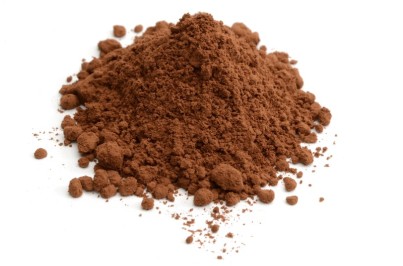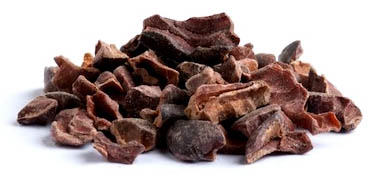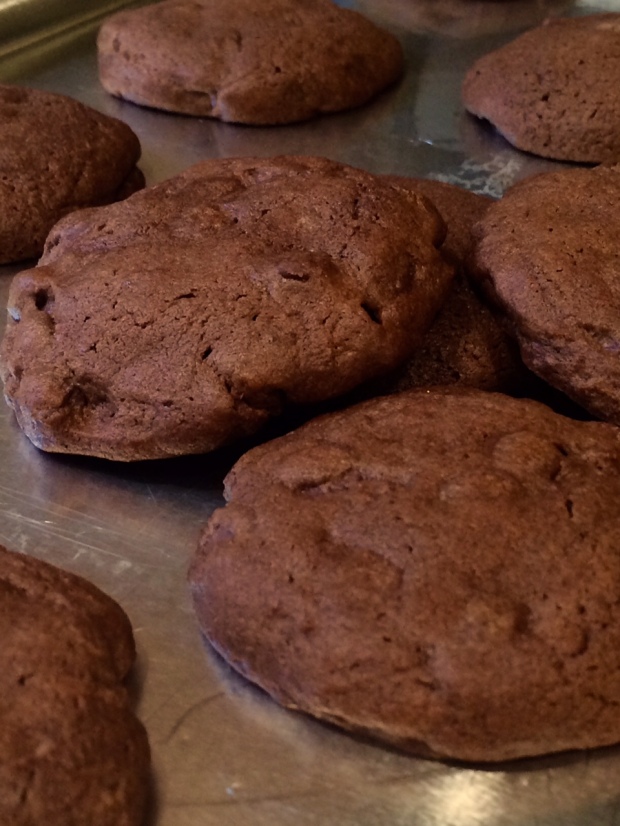All cocoa products, such as cocoa liquor, cocoa powder, cocoa butter, and chocolate, are made from cocoa beans. Cocoa fruit grows on trees in tropical areas of Central and South America and the Caribbean. First, farmers harvest the beans, allow them to ferment and dry, and then ship them to factories. Here, workers inspect the beans, clean them and strip them of their husks. Left behind are nibs- the inner sections of the kernel. These nibs are roasted to eliminate bacteria and enhance flavor.
Next, machines grind the hot nibs into a paste called cocoa mass or chocolate liquor (not to be confused with the alcoholic chocolate liqueur). The liquid consists of cocoa solids suspended in warm cocoa butter. The solids contain all of the flavor, while the cocoa butter is nearly tasteless.
Usually, the nibs are alkalized before, during, or after the roasting process. Cocoa beans are slightly acidic, with a pH around 5 or 6. In order to neutralize the cocoa, factories add an alkalizing agent such as potassium carbonate to the nibs. This not only raises the pH, but also eliminates some of the cocoa butter and gives the nibs a darker, reddish color. Additionally, some companies will increase the pH to around 8 for bittersweet chocolate. Then, under high pressure, machine press the cocoa butter out of the cocoa mass. Cocoa butter is a main ingredient in chocolate, but can also be used for cosmetic purposes.
Once the fat is removed, cocoa solid remains in the form of thin, dry cocoa cakes. When broken up, these cakes become cocoa powder.  Natural cocoa powder has not been alkalized, and therefore is slightly acidic. Recipes that call for natural cocoa powder often utilize baking soda to neutralize the acid and leaven the dough. Alkalized, or Dutch, cocoa powder, does not have this effect since it is neutral. Therefore, it should be used with baking powder, which does not require an acid to raise mixes or doughs. Finally, the extracted cocoa butter combines with cocoa mass, and sugar to create chocolate. The ingredients are mixed, rolled and conched. During conching, machines constantly move the chocolate, which allows it to cool and thicken evenly. It also helps acids escape.
Natural cocoa powder has not been alkalized, and therefore is slightly acidic. Recipes that call for natural cocoa powder often utilize baking soda to neutralize the acid and leaven the dough. Alkalized, or Dutch, cocoa powder, does not have this effect since it is neutral. Therefore, it should be used with baking powder, which does not require an acid to raise mixes or doughs. Finally, the extracted cocoa butter combines with cocoa mass, and sugar to create chocolate. The ingredients are mixed, rolled and conched. During conching, machines constantly move the chocolate, which allows it to cool and thicken evenly. It also helps acids escape.
Next, the chocolate cools slowly or tempers. This process helps cocoa butter crystalize properly to form smooth, not lumpy chocolate. Lastly, the chocolate fills molds and chills completely. When removed, it is ready to be packaged, shipped, sold, and, of course, eaten. Recipes may call for chocolate or cocoa powder depending on the desired taste and texture. Since cocoa powder is more concentrated, it yields a more prominent flavor than chocolate. On the other hand, the fat in chocolate produces creamy, silky texture. However, keep in mind at what temperature the dessert will be served. When cold, a cake made with chocolate may become dry and crumbly.
Double chocolate chip cookies utilize both cocoa powder and semisweet chocolate chips. Each bite is filled with a strong chocolate taste, chewy texture, and gooey, melted chocolate chips.
The dough has plenty of cocoa powder and chocolate chips.
The cookies are soft and chewy like brownies, but not too dense.
Enjoy!
Double Chocolate Chip Cookies
1 cup butter
3/4 cup sugar
3/4 cup brown sugar
2 eggs
1 tsp salt
2 tsp vanilla
1 tsp baking soda
1/2 cup unsweetened cocoa powder
3 cups flour
2 1/2 cups semisweet chocolate chips
Cream together the butter and sugar. Mix in eggs, salt, vanilla, and baking soda. Slowly add cocoa powder, then flour. Once combined, stir in chocolate chips.
Chill for 1 hour. Preheat oven to 350° F. Scoop out dough, roll into balls, and flatten slightly. Bake for 13 minutes.
Makes 48 cookies.








